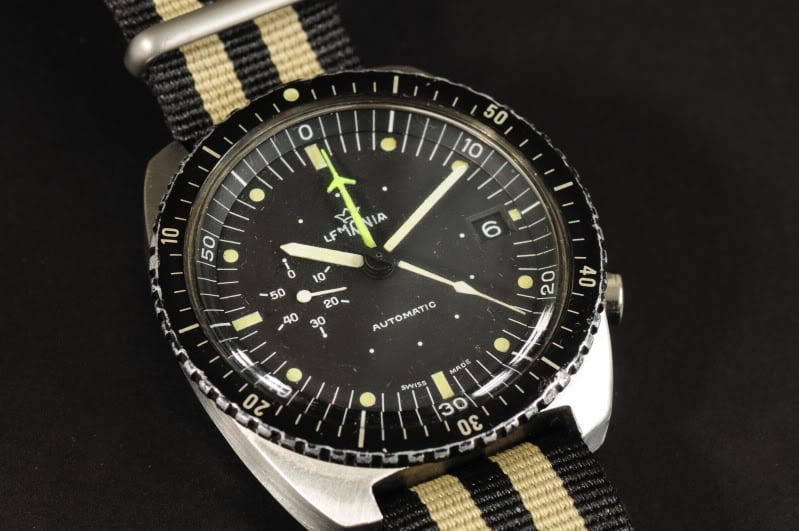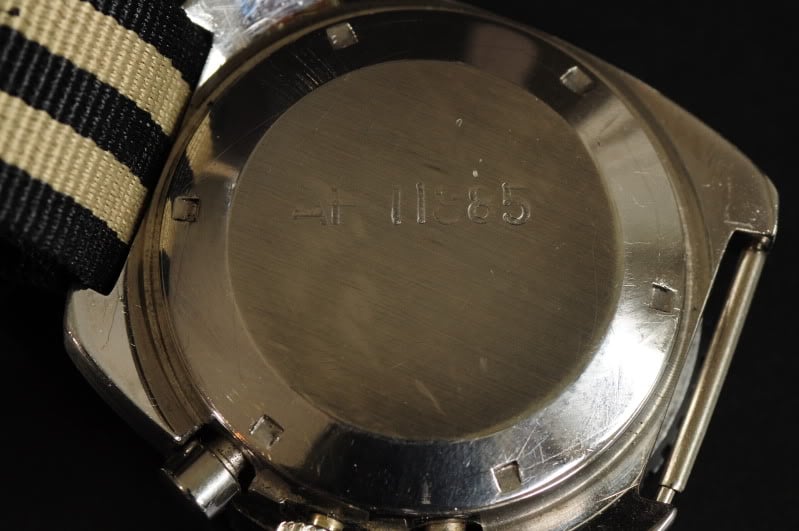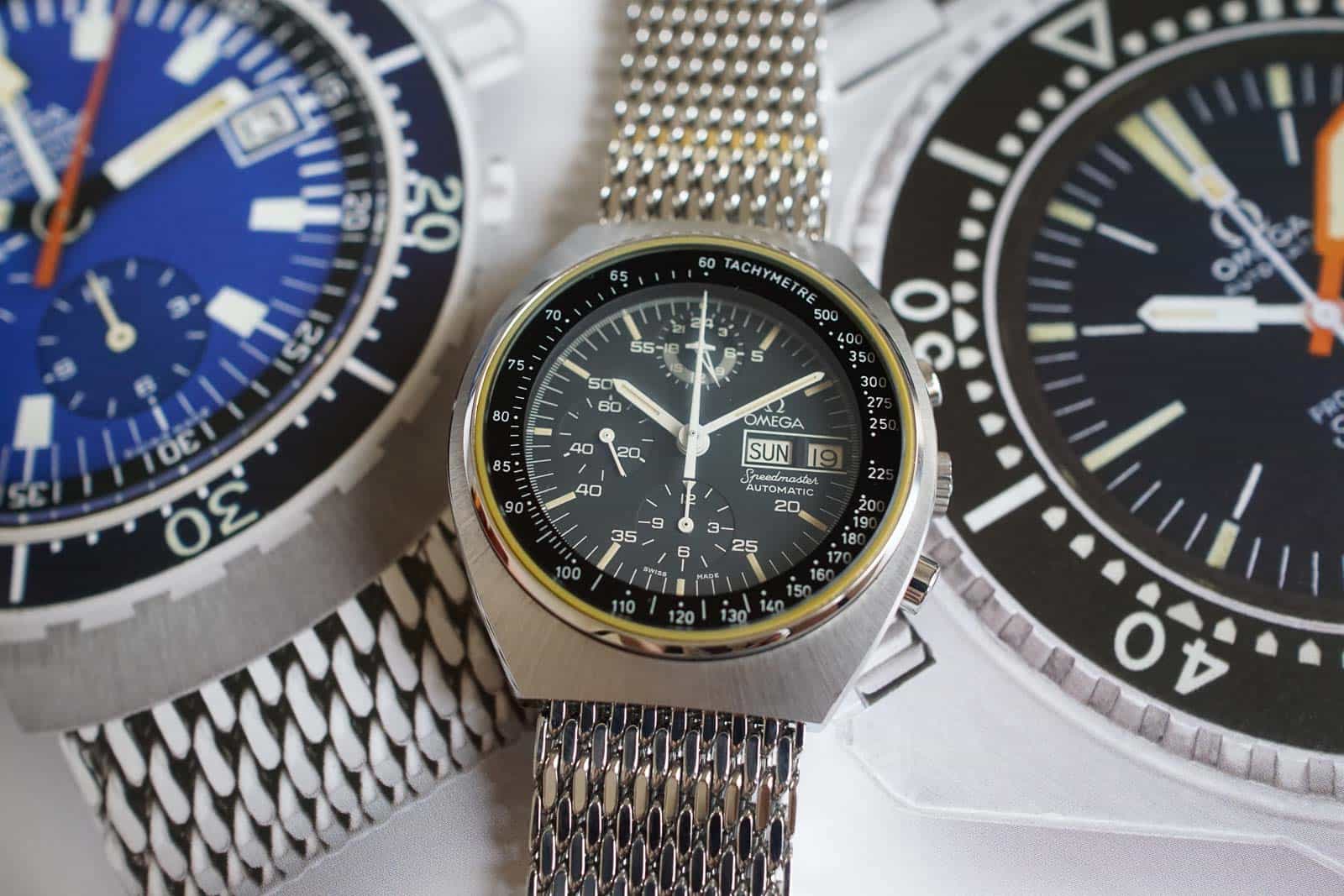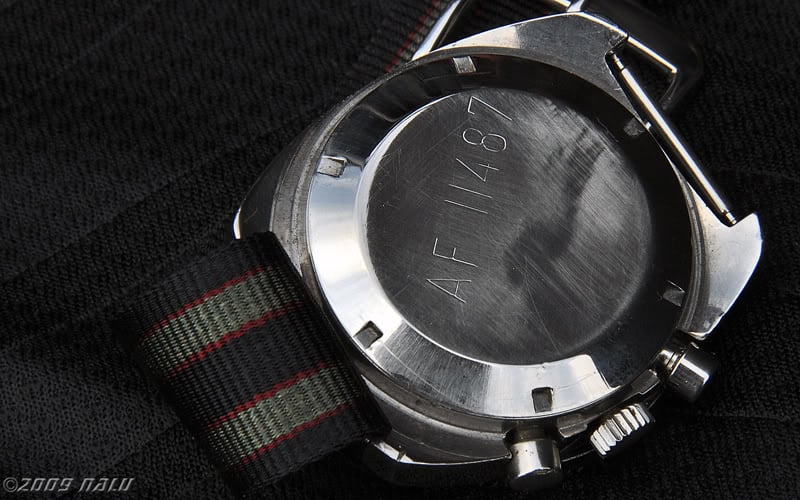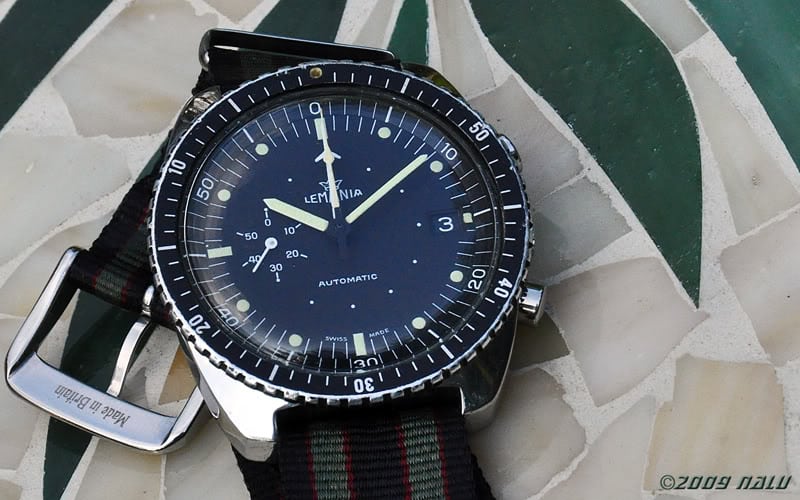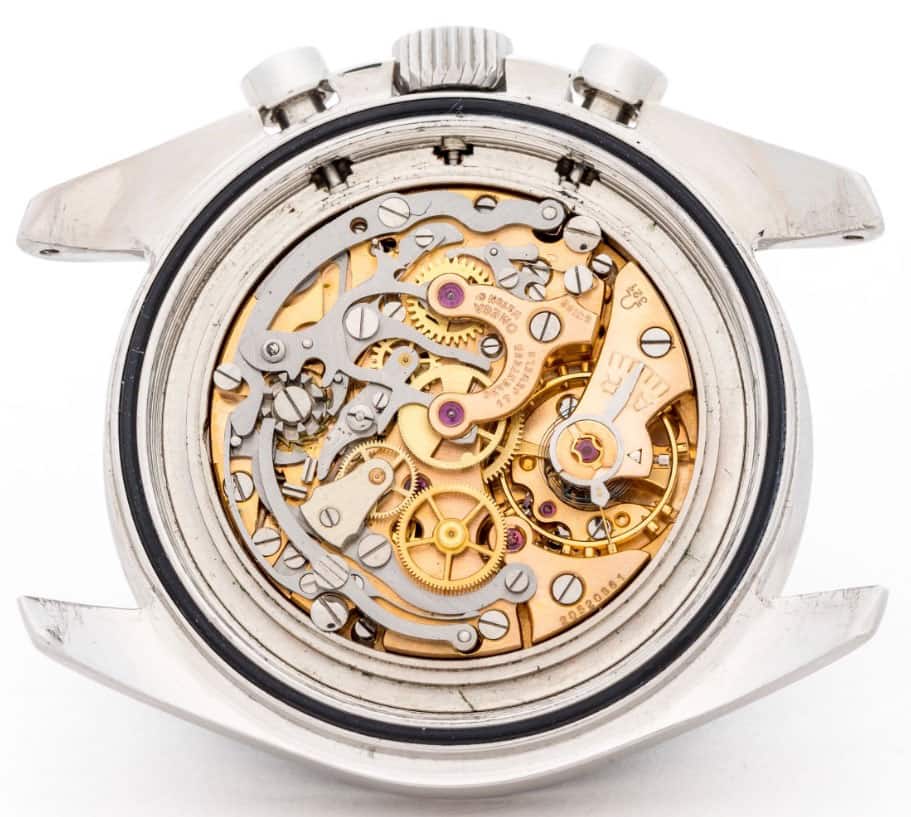Rare Bird: Lémania 5012 SAAF (South African Air Force)
Recently I bumped into a picture of a vintage watch that I had never seen before. It turned out to be a military watch by Lémania, issued to the South-African Air Force (SAAF) in the 1980’s and equipped with an iconic movement. Since it is not a watch you probably see very often, I tried to find out more about it.
Lémania 5012 SAAF
The Lémania 5012 SAAF was in use by South African Air Force pilots during the 1980s. It looks much more modern than the classic military watch. The black and greenish dial looks like a serious instrument. It seems to be quiet big, with its slightly domed glass providing a stretched view over a dial with one register (at 9) and a date window (at 3). The combination of bold minute and hour hands, two ready and waiting central counter hands and the interesting indexes with lots of dots and fine lines attracted me immediately.
A closer look suggests three scales surrounding the actual dial, while two pushers and a crown are hidden under the bezel. I started looking for a night shot of this one (didn’t find it), because there seems to be so much Lumina that it would look like a night panel. This watch would have me locking myself up in the toilet, like a kid, lights out, to check night visibility. Another interesting thing is that the Lémania SAAF looks quiet different from most other military watches. It doesn’t look like a classic diving watch. It is flatter than most diving watches, the dial looks more complex, like early Navitimers, while central jet-hand shows similarities to the Omega Speedmaster Mark series. Overall it has a more modern look.
SAAF
The watch was issued to the South African Airforce in 1980 in two batches of 400 pieces. The South-African Airforce (SAAF) has been using wristwatches for their personnel since the 1940’s. As a commonwealth air force, much equipment had RAF origins. Many early issued SAAF watches have SAAF and RAF markings. According to Rikus Basson’s website, the Weems Movado watch was the first timepiece used by SAAF aircrews, while the Lémania SAAF was the last mechanical SAAF-watch. The South-African Airforce used Longines, IWC Mark XI’s and Lémania’s since the 1950s. All were mechanical, analog watches, except the last issued watch, a digital Seiko quartz. It is unknown what time piece is issued to the SAAF staff these days.
Lémania 5100
The Lémania SAAF has the Lémania 5012 automatic chronograph movement inside. The ‘5012’ is a moderated version of the legendary Lémania 5100 movement. According to onthedash.com, ‘Lémania 5100 and 5012 chronographs have near cult status among those who collect vintage chronographs’. 5100 is an automatic chronograph movement, launched in 1978 and specifically designed as a response to the devastating low-cost Japanese quartz movements and their impact on the Swiss watch industry. The sturdy and accurate 5100 movement was extremely reliable and very popular for military. Sinn, Tutima, Fortis, Alain Silberstein, Paul Picot and Orfina used it a lot, as did Omega and Tissot. The 5100 movement could withstand heavy shocks (7G +) without affecting the chronograph, thanks to the directly driven chronograph mechanism. Most other chronographs have an intermediate wheel driving the chronograph, making it more vulnerable. Besides the fact that 5100 is rock steady, it keeps working without servicing for a long time – even up to seven years.
5012
The primary 5100 functions were displayed through four central hands: time (hour and minute hands) and two central chronograph counters (one for chronograph seconds and one for chronograph minutes). Also, there’s a subdial for chronograph hours (up to 24 hrs) at 12 o’clock, a continuous seconds counter, day and date. So, the 5100 provided a full set of functions. The 5012 is a downsized 5100. It has less sub dials. It has the four central hands, like the 5100 (for time and chronograph minutes and seconds) but just one subdial for continuous seconds, to see that the motor is running, and a small date window at 3. The 5012 provides a more modern look than its predecessor, with a highly legible dial layout. Also, the 5012 runs at a slower beat rate of 21,600bph as opposed to the 5100’s 28,800bph.
Hard to find
It is very hard to track solid information about these watches. Online sources report that the remaining Lémania’s and IWC’s were sold off to the SAAF personnel in the 1990’s (for 35 South African Rand each, which is about 5 euro’s). Many of them were then traded in for new digital Seiko’s. SAAF found out about this and just destroyed all remaining examples in storage and the ones returned by pilots thereafter. Only a few Lémania SAAF 5012 watches seem to have survived. I tried to check these facts, but SAAF never responded while Lémania (Breguet) couldn’t find proper information about the watch. According to a helpful specialist working at Breguet, ‘the company can’t provide any information about their military watches’, however ‘the SAAF-watches must have been produced whilst under the Breguet-flag’. The employee kindly adds in his reply ‘that there is enough information about these watches available online’. Jeff Stein’s HEUER-website OnTheDash adds interesting information. His article on a very similar looking chronograph learns that the watch has been issued to several military units and provide interesting images of the watch, inside and outside, although our SAAF-version shows some optical differences.
Collectible
The original price of this watch remains unknown, but it is possible to estimate its current value. If available information is correct, the watch is multi-collectible: 1) It is very limited in numbers: only 800 have been made and 2) many of them have been destroyed, as described above; 3) it is an issued military watch and 4) it is a vintage military watch from a collectible brand. 5) Lémania was mainly a movement manufacturer and 6) the watch features an interesting Lémania-movement. I cannot define whether this watch is based upon a diving watch, but if that is the case, we can add a seventh fact. These facts make this piece collectible and sought after, although it seems that is has been under the radar for a long time.
Value
Over the past years, it has been offered on eBay and other (online) auctions. There are only a few pictures of it on Instagram and if you Google it, you’ll also find a relatively limited number of images. According to chats in fora, the watch sold for just below thousand Euros on Ebay February 2007 and in May 2007 one sold for 3234 USD (this one had no bezel). In August 2013 An SAAF Lémania sold for £3,250 on eBay (item 261265589408). In September 2013 one was auctioned at liveauctioneers: 3200 GBP. In March 2015 a Lémania SAAF 5012 sold for just 5000 South African rand (today this would be approximately 342 euro’s), while another one was on eBay in September 2015 for EUR 4.728,90 (auction ended early). In December 2016 a dial and four hands for the Lémania 5012 SAAF are offered at eBay for about 1400 euro’s buy-it-now.
Highest price
The highest price for the Lémania 5012 SAAF was paid at an auction in September 2016. According to watches of Knightsbridge auctioneers, a Lémania 5012 SAAF was sold at auction for 9000 GBP (17 September 2016, LOT 176). The estimate for this watch was 2,500 GBP – 3,500 GBP, but the buyer must have paid 11,000 GBP for it, including commissions and taxes. The explanation for this new price record for the Lémania SAAF could be the fact that Hodinkee had mentioned the auction earlier, highlighting the Lémania amongst a few others. This must have triggered many bidders, who pushed the price. Although it is a price record for this watch, it is also doubtful wethere it is a new standard for this piece. At the time of writing this article during the last days of December 2016, there is a complete Lémania 5012 SAAF available at www.watchtime.co.za, a South-African online luxury watch shop, for 19,900 South African Rand. This is 1360 euro’s or 1167 GBP and only a fifth of the hammer price at Knightsbridge.
More information
It would be very interesting to find out more about this watch and the stories about it. The thoughts of solid archival information about the origins of this watch haunted me for week. Was it made just for SAAF? It is indicated that more military forces have used the watch. Was it an existing model? Did it have diving origins? I also dreamt about a conformation from the SAAF about the story of the destroyed watches. I saw it al before me, including pictures of officially signed documents confirming the deal between Lémania and SAAF. How cool would it be to receive personal communication from the officer who chose the watch for this military duty? Although Breguet was not able to help me further at this time, the friendly customer care manager sent a link to a story on another Lémania military chronograph, manufactured in 1975-1976 for the British Royal Navy. Only 500 examples of this magnificent and very sought after model left the manufacture Lémania of the Orient.
The history of Lémania
Alfred Lugrin
Lémania (or Lémania) is primarily famous as a movement brand, but there are also Lémania branded watches and stopwatches! Alfred Lugrin (born around 1858) originated the brand in 1918, L’Orient, near Lac de Joux. Alfred was the younger of two brothers who both developed a career in horology. His older brother left to the US to enhance his skills, while Alfred remained in Switzerland where he worked for several companies. In the late 1870’s he patented one of his chronograph designs. In 1884 he founded A. Lugrin S.A., in L’Orient. He also built minute repeaters and received a patent for a certain improvement in movements. Alfred also received a patent (Brevet No. 359) for improving his own chronograph movement. His company A. Lugrin S.A. became known as an innovative maker of chronograph movements and won awards for caliber designs and medals for entries in the 1906 Milan fair and the 1914 Bern fair.
Lémania movements
According to Swiss records, the name of the Lémania Watch Company was registered in the Canton of Vaud, March 12, 1918. About two years later Lugrin’s son-in-law, Marius Meylan, became managing director of the company. In 1932, Meylan had to come with a plan to save the Lémania Watch Company in the declining economy. He asked SSIH to purchase the company. SIHH consisted of Omega and Tissot and already used Lémania movements for their watches. So Meylan’s idea was interesting for both sides: the watch brands had free access to Lémania’s chronograph movements and Lémania could market watches under its own name, and did so for decades.
Piquet’s 321
One of the most talented designers at the time was Albert Piquet, who worked more than forty years at Lémania. He designed the Lémania 27-CHRO-12, released in 1942. This tri-compax chronograph with column wheel included 12-hour elapsed time indication. In collaboration with Omega, Piquet refined this movement, adding shock protection and an antimagnetic balance spring. Omega introduced the improved movement in 1946 as Cal. 321, which is now the famous first Speedmaster movement.
Lémania, Omega and the Speedmaster
After World War II, the watch industry slowly resurrected. Lémania and Omega revived their productions. In 1957 the Omega Speedmaster was presented: a beautiful, large chronograph watch equipped with Omega caliber 321. In 1965 Lémania came up with a new movement: Lémania 1873. Omega cal. 861 is based on this movement. From 1967, 861 replaced the 321 in the Speedmaster Professional. 861 had a flat balance spring and changed the shape of the main bridge. The switch from a column wheel to a shuttle/cam chronograph mechanism enabled less balance wheel screws.
Unique position
The many Nasa-missions and of course the moon landing were extremely powerful additions to Lémania’s reputation. Their chronograph movements became the basis of Patek Philippe, Audemars Piguet, Girard-Perregaux, Breitling and many other top-notch watch brands. And at all price ranges. The need for innovation and the commercial demand for improvements led to a new technical addition: a chronograph that could wind itself. Seiko, Breitling, Heuer, Zenith and Hamilton were the first with an automatic chronograph. Lémania presented their automatic chronograph movement in the early 1970’s. It came to the market as the movement of the Omega Speedmaster Mark III. The similarity between the Speedmaster and the South-Africa Airforce Lémania is that both watches have been selected for highly responsible (military) tasks. One became legend; the other one seems to be an unknown hero.
Nouvelle Lémania – Breguet
The 1970’s Japanese ‘quartz invasion’ had a huge impact on the Swiss watch industry. In 1981 Société Suisse pour l’Industrie Horlogère (SIHH) and Allgemeine Schweizerische Uhrenindustrie AG (AUSAG, the largest German-speaking manufacturer of watch movements) were in serious financial trouble. SSIH was almost forced to sell Omega to Seiko, but eventually they sold Lémania to a group of investors including the Piaget family. ‘Nouvelle Lémania’ – the renamed company – started designing and assembling watches under the Lémania brand. SSIH and AUSAG merged in 1983 and became The Swatch Group. In 1992, Groupe Horloger Breguet (GHB) bought Nouvelle Lémania, enabling superb movements for Breguet in the high-end mechanical watch market and in 1996 a new Lémania Manufacture was built in L’Abbaye, near Lac de Joux. In 1999 The Swatch Group purchased Groupe Horloger Breguet. Swatch Group CEO Nicolas G. Hayek had admired Breguet for years. Hayek also obtained Nouvelle Lémania, which enabled a complete Manufacture Breguet. Hayek restored Rue Alfred Lugrin 2, the historical Lémania building in L’Orient and replaced the Lémania sign with ‘Montres Breguet, S.A’. All signs of Lémania were removed but the brand’s horological legacy remains present in each and every magnificent Breguet made today.
Technical sheet SAAF Lémania 5012
- Calibre: Lémania 5012 Automatic
- Bph: 21,600
- Power reserve: 45 hours
- 17 Jewels
- Hacking
Breguet (in which Lémania submerged) and the South African airforce never responded to my requests for information on this watch, so I had to base my story upon online information. Fortunately, there are enough reliable online sources.
Header image by Coronet of the MWR Forum.

